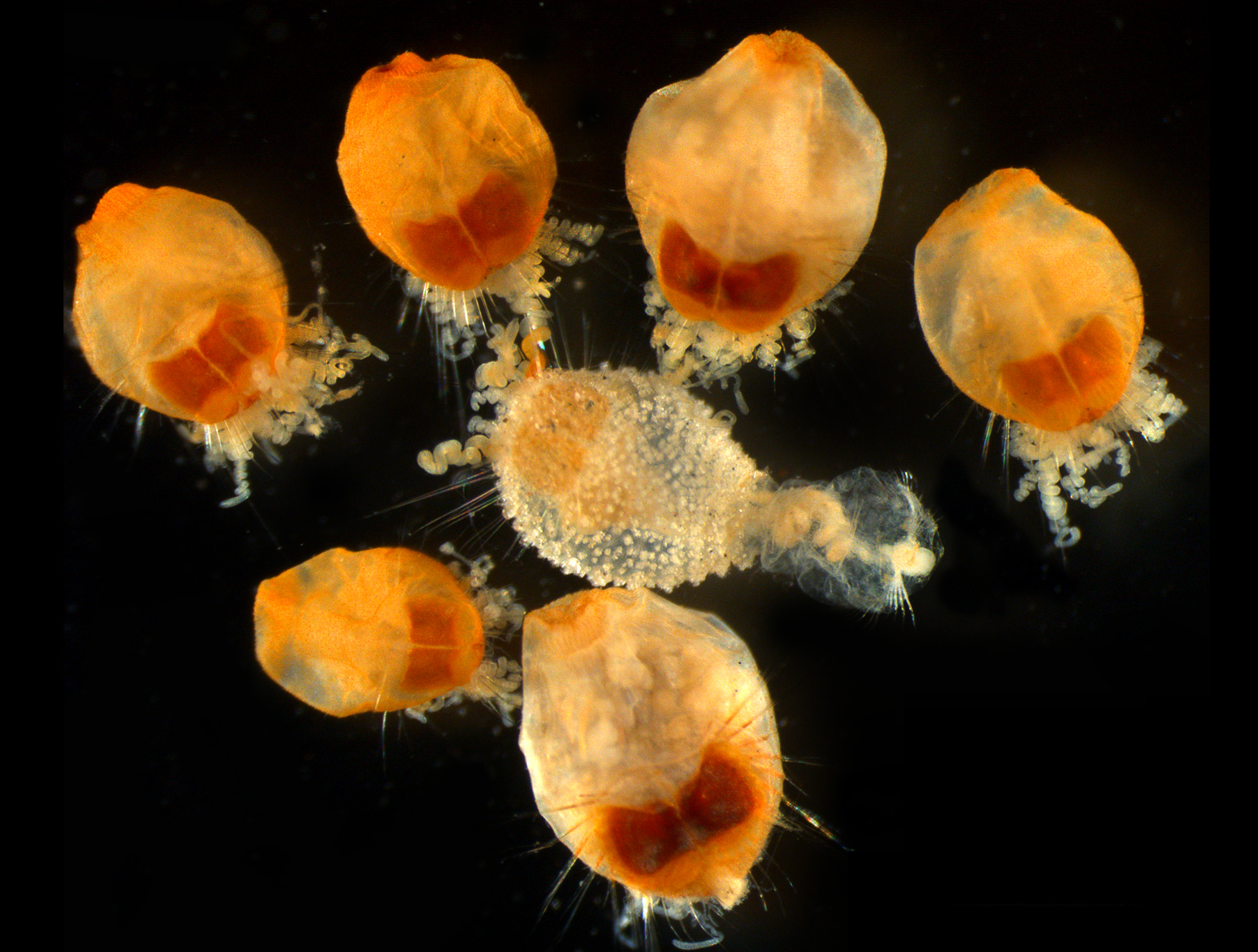Abstract
Five sternaspid species were found near Vietnam shores: Sternaspis britayevi sp. nov., S. costata von Marenzeller, 1879, S. nana sp. nov., S. papillosa sp. nov., and S. spinosa Sluiter 1882. Sternaspis britayevi is described from the shallow water in Vietnam inhabiting soft bottoms; it resembles S. spinosa described from Java and S. thorsoni Sendall & Salazar-Vallejo, 2013 described from the Persian Gulf, but differs in having a medially projected and markedly ribbed fan of the ventro-caudal shield and nearly parallel, distally widened and rounded branchial plates. Sternaspis nana sp. nov. is described from Nha Trang Bay; it differs from the other known species by the combination of the following characters: small size, evenly distributed micropapillae and regular rows of long cirriform papillae; posterior chaetal fascicles consisting of single thick chaeta; a ventral shield with smooth integument, without ribs and usually without concentric lines. Sternaspis papillosa sp. nov. is also described from Nha Trang Bay; it resembles S. africana Augener, 1918 and S. andamanensis Sendall & Salazar-Vallejo, 2013 by having similar ventro-caudal shields but differs by body papillation and details of the ventro-caudal shield. Based upon observations of different species some morphological features are clarified: 1) notochaetae are present in introvert chaetigers as delicate capillaries; 2) peg-chaetae are really a dense group of more than 100 thin individual chaetae, embedded in a fibrous matrix, and covered by a common sheath; 3) the pharynx is an eversible, lobed, axial non-muscular proboscis with a ciliated surface; 4) the body cavity is divided by three septa in the anterior body region, and there are no other septa; and 5) an eversible anal peduncle is confirmed, as has been shown by early taxonomists.
References
Augener, H. (1918) Polychaeta. Beitrage zur Kenntnis der Meeresfauna Westafrikas. Vol. 2, Herausgegeben von W.Michaelsen. L. Friederichsen & Co., Hamburg, pp. 67–625.
Carus, J.V. (1863) Vermes. Handbuch der Zoologie, W. Engelmann, Leipzig. 2, 422–484.
Fauchald, K. & Jumars, P.A. (1979) The diet of worms: a study of polychaete feeding guilds. Oceanography and Marine Biology Annual Review, 17, 193–284.
Fiege, D. (2016) Sternaspidae Carus, 1863. Handbook of Zoology Online. De Gruyter. Avaliable from: http://www.degruyter.com/databasecontent (Accessed 19 Jan. 2017)
Gallardo, V.A. (1968) Polychaeta from the Bay of Nha Trang, South Vietnam. Scientific Researches on the Marine Invertebrates of South China Sea and the Gulf of Thailand, 1959–1961. NAGA Report, 4, 35–279.
Goodrich, E.S. (1898) Notes on the anatomy of Sternaspis. Quarterly Journal of Microscopical Science, 40, 233–245.
Hausen, H. (2005) Chaetae and chaetogenesis in polychaetes (Annelida). Morphology, molecules, evolution and phylogeny in Polychaeta and related taxa. Bartolomeus, T. & Purschke, G. (eds). Hydrobiologia, 535/536, 37–52.
Jumars, P.A., Dorgan, K.M. & Lindsay, S.M. (2015) Diet of worms emended: an update of polychaete feeding guilds. Marine Science, Annual Review, 7, 497–520.
http://10.1146/annurev-marine-010814-020007Otto, A.G. (1821) Animalium maritimorum nondum editorum genera duo. Verhandlungen der Kaiserlichen Leopoldinisch- Carolinischen Akademie der Naturforscher, 10, 618–634. [pls. 50–51.]
Petersen, M.E. (2000) Family Sternaspidae Carus, 1863, including a review of described species and comments on some points of confusion. In: Blake, J.A., Hilbig, B., Scott, P.H. (eds). Taxonomic Atlas of the Benthic Fauna of Santa Maria Basin and the Western Santa Barbara Channel. Volume 7, The Annelida Part 4, Polychaeta: Flabelligeridae to Sternaspidae. Santa Barbara Museum of Natural History, Santa Barbara, pp. 311–336.
Ranzani, C. (1817) Descrizione di una nuova specie del genere Thalassema. Opuscoli scientifica, 2, 112. [Oken’s Isis 12–13 (183), 1457–1461. [Transl. German with additional comments]
Rietsch, M. (1882) Étude sur le Sternaspis scutata. Annals des Sciences Naturelles Paris, Zoologie, série 5, 13, 1–84.
Rouse, G. & Pleijel, F. (2001) Polychaetes. Oxford University Press, Oxford, 354 pp.
Salazar-Vallejo, S.I. (2014) Three new polar species of Sternaspis Otto, 1821 (Polychaeta: Sternaspidae). Zootaxa, 3861 (4), 333–344.
http://10.11646/zootaxa.3861.4.3Salazar-Vallejo, S.I. & Buzhinskaja, G. (2013) Six new deep-water sternaspid species (Annelida, Sternaspidae) from the Pacific Ocean. ZooKeys, 348, 1–27.
http://dx.doi.org/10.3897/zookeys.348.5449Sendall, K. & Salazar-Vallejo, S.I. (2013) Revision of Sternaspis Otto, 1821 (Polychaeta: Sternaspidae). ZooKeys, 286, 1–74.
http://dx.doi.org/10.3897/zookeys.286.4438Sluiter, C.P. (1882) Ueber einen indischen Sternaspis und seine Verwandschaft zu den Echiuren. Tijdschrift voor Natuurkundig Nederlandsch-lndie, Batavia, 41, 235–287.
Sluiter, C.P. (1890) Die evertebraten aus der Sammlung des koniglichen naturwissenschaftlichen vereins in nieder Hindisch lndien in Batavia. Zugleich eine Skizze der Fauna des Java- Meeres, mit Beschreibung der neuen Arten. Natuurkundig Tijdschrift voor Nederlandsch- lndie, 50, 102–123. [Pls. 1–2.]
Stimpson, W. (1853) Synopsis of the marine Invertebrata of Grand Manan: or the region about the mouth of the Bay of Fundy. Smithsonian Contributions to Knowledge, 6, 5–67.
Tzetlin, A. & Purschke, G. (2005) Pharynx and intestine. In: Bartolomaeus T, Purschke G (eds) Morphology, Molecules, Evolution and Phylogeny in Polychaeta and Related Taxa. Hydrobiologia, 535/536, pp. 199–225.
Tzetlin, A. & Zhadan, A. (2009) Morphological variation of axial non-muscular proboscis types in the Polychaeta. Zoosymposia, 2, 415–427.
Vejdovský, F. (1882) Untersuchungen über die Anatomie, Physiologie und Entwicklung von Sternaspis. Denkschriften der Mathematisch-Naturwissenschaftlichen Classe der kaiserlichen Akademie der Wissenschaften, 43, 33–90. [Pls. l–10.]
von Marenzeller, E. (1879) Südjapanische Anneliden (Amphinomea, Aphroditea, Lycoridea, Phyllodocea, Hesionea, Syllidea, Eunicea, Glycerea, Sternaspidea, Chaetopterea, Cirratulea, Amphictenea.). Denkschriften der Mathematisch Naturwissenschaftlichen Classe der kaiserlichen Akademie der Wissenschaften, 41, 109–154.
Wu, X.W., Salazar-Vallejo, S.I. & Xu, K.D. (2015) Two new species of Sternaspis Otto, 1821 (Polychaeta: Sternaspidae) from China seas. Zootaxa, 4052 (3), 373–382.
http://dx.doi.org/10.11646/zootaxa.4052.3.7

